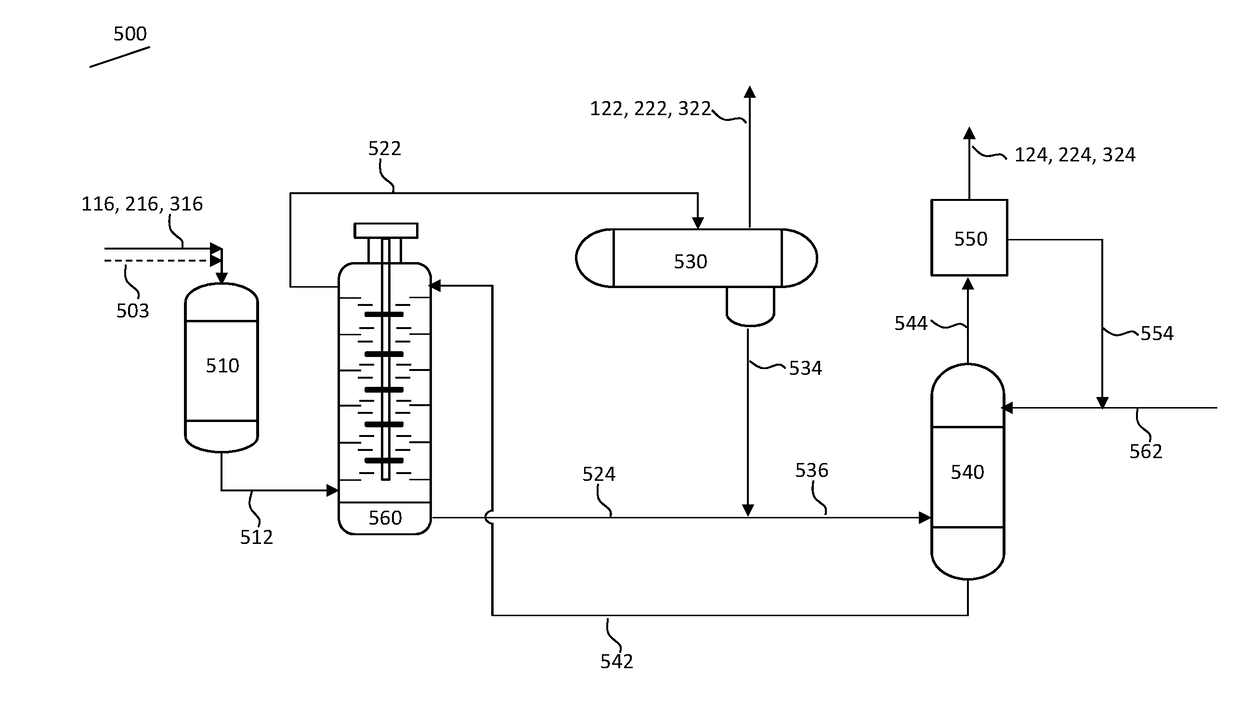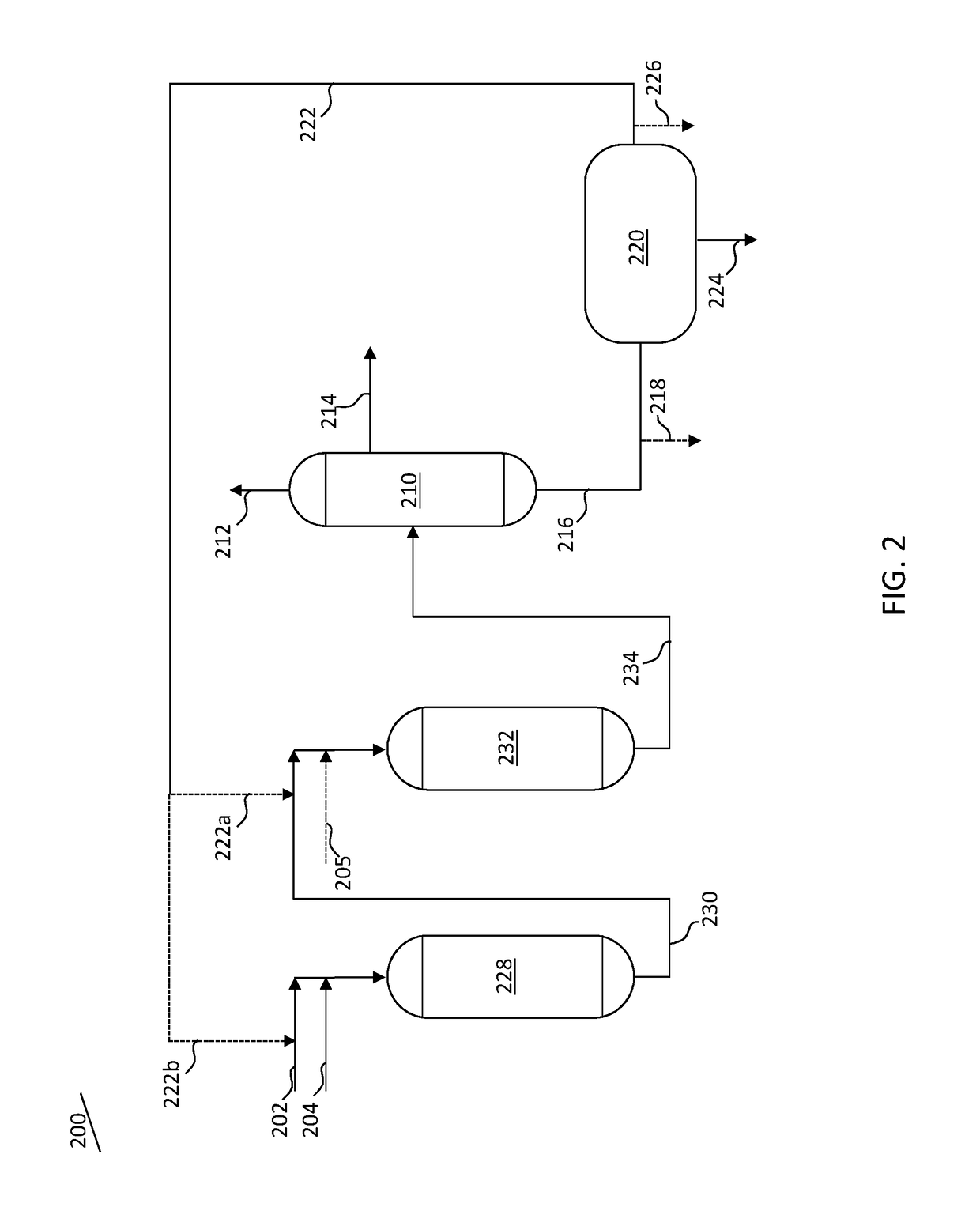Hydrocracking process and system including separation of heavy poly nuclear aromatics from recycle by ionic liquids and solid adsorbents
- Summary
- Abstract
- Description
- Claims
- Application Information
AI Technical Summary
Benefits of technology
Problems solved by technology
Method used
Image
Examples
example 1
Ionic Liquid Extraction
[0105]A mixture of 80 grams of hydrocracking unit bottoms and 20 grams of the ionic liquid, 1-butyl-3-methylimidazolium-hexafluoro phosphate was heated to 50° C. and continuously stirred for 30 minutes at 50° C. Thereafter, 100 cc of pentane was added to the mixture with stirring to assure thorough contact of the constituents. The mixture was transferred to a separatory funnel to separate the ionic liquid and oil-pentane mixture. The pentane was evaporated from the oil-pentane mixture in a rotary evaporator and the treated hydrocracking unit bottom stream was recovered. The material balance for the example is shown in Table 1.
example 2
Ionic Liquid Extraction Followed by Adsorption
[0106]A mixture of 80 grams of hydrocracking unit bottoms and 20 grams of the ionic liquid, 1-butyl-3-methylimidazolium-hexafluoro phosphate was heated to 50° C. and continuously stirred for 30 minutes at 50° C. Thereafter, 100 cc of pentane was added to the mixture with stirring to assure thorough contact of the constituents. The mixture was transferred to a separatory funnel to separate the ionic liquid and the oil-pentane mixture. The oil-pentane mixture was passed thru a column containing 60 grams of attapulgus clay. The column effluents are collected and more pentane was added until a colorless effluent was obtained from the column. The pentane was evaporated in a rotary vaporator and a treated hydrocracker bottom stream was obtained. The material balance for this example is shown in Table 1.
example 3
Adsorption Followed by Ionic Liquid Extraction
[0107]A mixture of 80 grams of hydrocracking unit bottoms and 100 cc of pentane was stirred to dissolve the oil. The solution was passed thru a column containing 60 grams of attapulgus clay. The column effluents were collected and more pentane was added until a colorless effluent was obtained from the column all of which were collected and mixed with 20 grams of the ionic liquid, 1-butyl-3-methylimidazolium-hexafluoro phosphate. The mixture was heated and maintained at 50° C. with continuous stirring for 30 minutes. The mixture was transferred to a separatory funnel for separation of the ionic liquid from the oil phase. The pentane was evaporated in a rotary vaporator and the treated hydrocracker bottom stream was recovered. The material balance for this example is shown in Table 1.
TABLE 1Material BalanceExample123Hydrocracker bottoms80.080.580.3Ionic Liquid*20.020.120.1Total In100.0100.6100.4Treated Hydrocracker Bottoms80.180.178.3Ionic...
PUM
| Property | Measurement | Unit |
|---|---|---|
| Temperature | aaaaa | aaaaa |
| Pressure | aaaaa | aaaaa |
| Angle | aaaaa | aaaaa |
Abstract
Description
Claims
Application Information
 Login to View More
Login to View More - R&D
- Intellectual Property
- Life Sciences
- Materials
- Tech Scout
- Unparalleled Data Quality
- Higher Quality Content
- 60% Fewer Hallucinations
Browse by: Latest US Patents, China's latest patents, Technical Efficacy Thesaurus, Application Domain, Technology Topic, Popular Technical Reports.
© 2025 PatSnap. All rights reserved.Legal|Privacy policy|Modern Slavery Act Transparency Statement|Sitemap|About US| Contact US: help@patsnap.com



